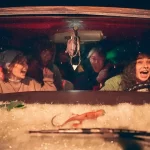Ebertfest 2014: Opening Night, by Aaron Pinkston
In her opening statements, Chaz Ebert, the face and soul of the Roger Ebert’s Film Festival, told a brief story about the unveiling of Roger’s statue, which is happening on the second day of this year’s festival. Roger and Chaz’s long-time friend decided to make it her mission to make the memorial come to fruition despite her own serious health problems. She approached talented artist Rick Harney, who is known for statues of other great sons of Illinois, Abraham Lincoln and Adlai Stevenson. Though he wasn’t currently taking any commissions, when he heard this project was for the late film critic, he jumped at the job. It turns out, Harney had a special love for Ebert’s work, as many of us do. For Harney, Ebert’s reviews were a way for him to connect with his autistic son. The work allowed them to have serious and insightful discussions on film together — a hallmark of Ebert’s legacy and a major reason why thousands of people from across the world travel to Champaign, Illinois each April, for the past 16 years. This story shows the incredible reach Roger Ebert had, not just as a film critic, but as a person.
This year is a particularly important year for the Roger Ebert’s Film Festival, as this is the first year without any guidance from the festival’s namesake. A major reason this event has become so beloved and special among film festivals that may have more clout or that are more in the public eye is its singular vision — these are films that are all beloved by one man. Due to the inescapable circumstances, this year will set the tone for any future festivals. There are still plenty of films on this year’s schedule that were wholeheartedly championed by Roger Ebert (I am particularly looking forward to Do the Right Thing and Born on the Fourth of July, among others), but the festival will also showcase new films that couldn’t have been seen by Roger, but fully carry the themes and stories that he would have certainly championed.
This year’s opening night film is a bit different and in the scope of things. Life Itself, adapted from Roger’s memoir, examines Roger Ebert’s life from his humble beginnings to his fight against cancer. Though the film premiered earlier this year at Sundance, there isn’t a more perfect place to see it. At times it was almost surreal, especially thinking about the experience of attending last year’s festival, a few weeks after Roger passed away, and seeing the intimate moments director Steve James captured with Roger and Chaz and the footage that was shot in Champaign last year.
James has long been a favorite of Ebert — his Hoop Dreams was given the “Great Movie” tag along with a four-star review, but the documentarian has never had one of his films play at the festival until now (I guess making a film about the man gives you a pretty good shot to get in). Life Itself thankfully isn’t just a selection for ego, but a pretty darn good profile documentary. Ebert was known as a great storyteller, and so James fills the film with a number of great stories — I wish it was able to dig a bit deeper in many of the anecdotes, but strung together, they adequately showcase an incredible life. Life Itself is poignant, tragic, but incredibly funny, just like Roger. Many times through the screening, the audience was laughing so loudly and for so long that the sound of the film was drowned out. Some of the film’s highlights include the wild misadventures of a young man who was the life of the party and, obviously, the footage of his interplay with his greatest friend and rival Gene Siskel during their work on television — many of their show’s outtakes and arguments have become legendary, and for good reason.
The film’s biggest achievement, however, is that it is a film about a man first, not just a film critic. Most anyone who comes to see this film will inevitably be familiar with Ebert’s work, and though he was a very public figure, Life Itself gives a complete and honest portrayal of his life. I imagine that even if you’ve somehow never read one word of his work, you’ll come to understand his greater importance and love the man just as much as someone who has read every word.
During the Q&A, James remarked that the film’s goal in filming Ebert’s recovery from cancer was to film him attending screenings, conferences, events, parties, in order to show that he had the exact same vigor and verve that he was famously known for. Because of his worsening health, however, this couldn’t happen, but the end goal was still met. The deterioration of Ebert’s bodily functions and the procedures he had to undergo isn’t manipulated or softened by James, but Ebert’s spirit shines through the frame as if letting everyone watching know that everything was OK. Even without the ability to speak, Roger had an uncanny ability to communicate and James captures that incredibly well.
Before the film proper, the Ebertfest audience was first shown a “deleted scene” which looked specifically at the festival. In his introduction, James noted that this wasn’t included in the film because the filmmakers wanted to keep a running list of Ebert’s accomplishments to a minimum, but the scene itself was an interesting primer on the origins and appeal of Ebertfest. It also talked briefly about Roger’s love for a certain restaurant that serves steakburgers and shakes, which was a funny aside.
Looking ahead, the second day of the festival includes the first two academic panels on the schedule, as well as three screenings: the underseen Museum Hours, crowd-pleaser Short Term 12, and the dark comedy Young Adult. Until then.




























